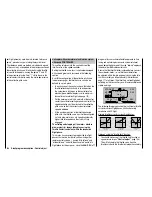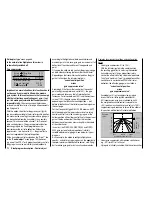
160
Detail program description - Control adjust
AI
FL
FL2
FL2
FL
AI
If the airbrake mixers are set as described above, then a
special fl ap combination – also referred to as the
"crow
position
" or
"butterfl y
" – can be confi gured: With this
airbrake setting, both
ailerons move moderately upwards
while the
fl aps move as far as possible downwards
.
A further mixer – see below, under the section "Elevat
curve" – is then used to trim the elevator in such a way that
the model's airspeed changes very little compared to the
normal fl ight position. Otherwise, there is a danger that the
model loses too much speed and then, after the braking
system is retracted (e. g. to extend a landing approach that
was too short, for example), pancakes or even stalls.
A tip for "seeing" the effect of brakes:
lift the fl aps and look over and under the surface from
the front. The larger the surface projected by the lifted
fl ap, the greater the braking effect achieved.
Tips for activating airbrakes:
If you have installed a servo for operating
•
conventional wing-mounted airbrakes in addition to
the aileron and fl ap servos, the simplest method of
controlling it is to connect it to the receiver output
whose input you have selected for the brake function,
i. e. either 1, 7, 8 or 9 – assuming it it is free. If this is
not possible, then as an alternative you can set a free
mixer, which connects up the brake control channel
you have selected with the airbrake servo channel.
To activate two airbrake servos, the best approach
•
is to leave one servo on output 1 and to connect the
second servo to a free output of your choice – for
example, output 8. You then also assign this output
to transmitter control 1 (as standard) on the "
Control
adjust
" menu (page 96) – see screen image:
Input 5
offset
0%
0%
0%
–––
0%
Input 6
Input 7
Input 8
–––
–––
GL
GL
GL
GL
typ
nor mal
Ct1
As you do, leave the settings for offset, travel, etc. at
their default values. Also leave the default value at
"GL" in the "typ" column, since the second airbrake,
like the fi rst, should be active in the same way across
all fl ight phases.
AI
FL
FL
AI
Servo 1
Servo 9
You can assure yourself that this works as stated
by accessing the "
Servo display
" menu, which you
can access from almost any menu level by briefl y
pressing the
keys on the left touch pad at the
same time (see page 230):
"AILE" column
•
When braking the model as it comes in to land,
neither of the two aileron fl aps should ever be
defl ected more than half of the possible travel
upwards, to ensure that enough travel is available to
control the model along its longitudinal axis (aileron
function).
AI
FL
FL2
FL2
FL
AI
"FLAP" (and "FLAP2") column
•
As the model is braked on the landing approach,
both pairs of fl aps can be set to defl ect by different
amounts, e. g.:
AI
FL
FL2
FL2
FL
AI
AI
FL
FL2
FL2
FL
AI
Combining AILE and FLAP for "Crow"
•
Summary of Contents for mx-20 Hott
Page 41: ...41 Your notes...
Page 49: ...49 Your notes...
Page 55: ...55 Your notes...
Page 81: ...81 Your notes...
Page 85: ...85 Your notes...
Page 89: ...89 Your notes...
Page 99: ...99 Detail program description Control adjust...
Page 127: ...127 Detail program description Control adjust...
Page 131: ...131 Detail program description Control adjust...
Page 163: ...163 Detail program description Control adjust...
Page 191: ...191 Detail program description Control adjust...
Page 207: ...207 Detail program description Control adjust...
Page 228: ...228 Detail program description Control adjust...
Page 229: ...229 Detail program description Control adjust...
Page 251: ...251 Detail program description Control adjust...
















































